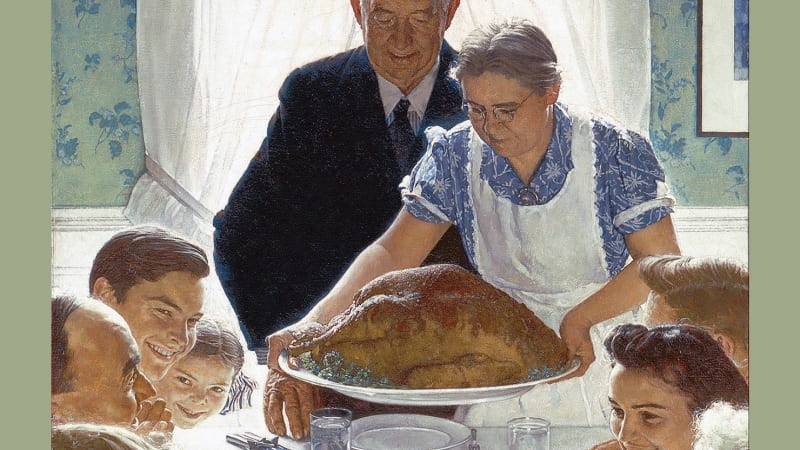A HOLIDAY GUIDE: TALKING WITH FAMILY ABOUT CLIMATE CHANGE
By: Jamie McFarlin, Laura Larocca, G Everett Lasher, Yarrow Axford

Norman Rockwell’s Freedom From Want, originally published in the Saturday Evening Post and inspired by FDR’s 1941 State of the Union Address.
After a divisive election, many of us are expecting a big helping of awkward family conversation with our holiday meals this year. Talking about the weather isn’t even safe territory anymore, given what your uncle may think about climate change. As climate scientists, we sympathize. We have uncomfortable conversations about climate change almost everywhere we go. So in solidarity, we offer some holiday tips about how to talk with family members about climate change.
1. Be patient: The task is challenging because any individual’s opinions on climate change are notoriously entrenched, so don’t expect to quickly change someone’s perspective. Our brains may be partly to blame for why many of us ignore climate change, as George Marshall discusses in his book, Don’t Even Think About It. We are wired to respond to external threats from recognizable enemies and not so much to collective behavior that is unintentionally harmful.
For better or worse, that makes your unconcerned family members pretty normal. As the election demonstrated, many of us experience an ideological echo chamber on social media and aren’t commonly exposed to perspectives that challenge our beliefs. But in a 2013 study by the Yale Program on Climate Change Communication, Americans claimed that their family and friends had the greatest ability to motivate them to take action on climate change. So when Uncle Mel winks and asks how you can possibly believe in that climate change stuff, talk with him about it. You, more than most people, may have the power to make a difference.
2. Try to connect on an emotional level. Do not assume your family member’s opinion derives from ignorance; instead, it may reflect deeply held values. Explain why you care about this. Are you concerned about the costs of protecting coastal infrastructure as the ocean rises? Worried about climate refugees? This shifts the conversation to your own hopes and fears, and theirs–and hopefully, some of the things you value are also important to your dinner companions. Listen to their specific concerns and address these individually and with a level head. A condescending lecture on “the facts” may only be alienating.
Sure, state that you are thoroughly convinced that humans are causing destructive changes in Earth’s climate. Add that nearly all climate scientists and scientific societies around the world agree. (If you need some sources, Wikipedia summarizes many ways in which the scientific consensus has been assessed, including and well beyond the extensively vetted reports of the UN-organized Intergovernmental Panel on Climate Change.) But start with reasons and motivations to get the conversation flowing.
3. Point out that transforming our energy system is a win-win. According to a report by the International Renewable Energy Agency, in 2015 U.S. solar sector jobs grew 12 times faster than U.S. jobs overall, and China employed more people in renewable energy jobs than in oil and gas.
Regardless of what happens with climate, a diversified energy supply has many benefits for the U.S. Expanding jobs and opportunities in R&D and manufacturing; an electricity grid that is more secure from natural disasters and terrorism; more efficient technology (who doesn’t want their gas or electricity bill to be cheaper?); and cleaner air to breathe, which means better health, are just a few of the upsides. Such opportunities, along with concerns about the business risks attending climate change, have already led a long list of companies from Intel to Kellogg to send a recent statement to President-Elect Trump warning that “failure to build a low-carbon economy puts American prosperity at risk.
The world overall is moving to diversify its energy mix for a host of reasons, meaning that there are big and growing market opportunities for U.S. companies and workers to fill. The U.S. can invest in creating new technologies that can be sold to huge, expanding markets in China and India and beyond – an opportunity too good to pass up in this uncertain economy.
4. If you haven’t had too much wine at that family dinner (or maybe because you have), you may decide to dive directly into the research underpinning the scientific community’s concerns. Social science suggests the strategies above may be more effective at connecting with people, but if you want to dive deeper, here’s our Holiday Cheat Sheet addressing common questions:
______________
Cousin S: Is Earth really warming?
Yes, it’s getting hot in here. 2016 is set to surpass 2015 as the hottest year globally since meteorological records began in the 1800s.
The current decade is also the warmest decade over that time. The last three decades of the 20th Century were probably the warmest 30-year period in the past 1,400 years, according to a major geological study by more than 70 researchers from around the world. (NASA’s website is a great reference if you’d like more on the historical temperature data.) Snow and ice have also diminished globally over recent years, while sea level has risen (see the Intergovernmental Panel on Climate Change report for more information).
______________
Uncle M: But what about that cold snap we just had? So much for things getting hotter!
Climate and weather are different. Climate is the long- term trend, averaged over decades, whereas weather is what happens from day to day. A single day or season of unseasonable weather doesn’t contradict the long-term trend, which is measured in decades and even centuries. (Here’s a cute dog-walking video that illustrates the difference.)
______________
Cousin G: How do we know that humans are the cause of this warming?
Carbon dioxide has increased by more than 40% in Earth’s atmosphere since the Industrial Revolution. This is a remarkable shift, even compared with natural variations over hundreds of millennia.
How do we know this? We measure the current level in the atmosphere at observatories around the world and compare it with bubbles of ancient atmosphere that are preserved deep in layers of Antarctic ice (these extend back continuously for 800,000 years). When we compare these air samples, the current abundance of carbon dioxide is unprecedented. Researchers at the U.S. National Oceanic and Atmospheric Administration have created an eye-opening video to show this.
How can we pin this rise on humans? Carbon comes in several varieties (varying in the number of neutrons), which have distinct sources – these serve as traceable signatures of origin. Most of the new carbon atoms in our current atmospheric readings bear the fingerprints of plants that have been dead for many millennia – a smoking gun, incriminating fossil fuels as their biggest source.
______________
Auntie X: There was a pause in the warming.
OR Okay, Earth is warming but this is caused by natural cycles of the Sun.
OR Carbon dioxide is just a trace gas. Besides, Earth has been warmer before. They were growing grapes in England during the Medieval Warm Period.
If you hear these points, you are probably dealing with a determined contrarian. Every one of these talking points has been repeatedly and publicly debunked with data and explanations for why these points are either incorrect or beside the point are widely available. You may find it more rewarding to connect with this family member on a personal level to start. Remember the key approaches above: be patient, connect, listen, point out the benefits.
______________
Cousin G: Climate has always changed. So why worry about this particular change?
Yes, periods of major warming and cooling have occurred naturally in the past, but this was due to different causes than the human forces turning the knobs on our climate today. Plus, our planet changed dramatically in response to those climate changes.
Geologic records demonstrate that the five biggest mass extinctions in Earth’s past — which each wiped out at least 75% of the living species at the time — were associated with periods of global climate instability (here’s a nifty diagram from Scientific American). Without conservation efforts, we could see comparable biodiversity losses in the coming centuries – a sixth mass extinction, which nowadays would jeopardize our food chain and many parts of our economy. (See the 2011 study published in Nature for more details.)
Also, although Earth has experienced major climate swings through its long history, modern civilizations and infrastructure all developed in the past few millennia, during a period of relatively stable climate. Our huge coastal cities were built during this period of correspondingly stable sea level.
Warming affects everything about Earth’s surface, not just thermometers – including where our coastlines fall and where rain falls – and those things, in turn, affect us. A lot.
For example, climate models project with confidence that as the earth warms we’ll see more intense storms (meaning more flooding of sewers here in Chicago, for example); more devastating storm surges with sea-level rise; and prolonged periods of drought in places that are already dry. This is already a reality for many people, like the farmers of Central California where water supply and crop production have already been impacted by prolonged drought.
______________
Uncle P: Can’t we solve the problem later?
Carbon dioxide is what’s known as a “long-lived” greenhouse gas. As climate scientist David Archer describes eloquently in his book, The Long Thaw, most of the carbon dioxide we add to the atmosphere now will remain there for centuries. Much of it will remain for millennia.
We’re adding carbon to our atmosphere faster than it goes away, compounding the problems and snowballing the effects – which is causing an ever-growing problem for our kids and their offspring to tackle. Meanwhile, the effects of climate change are happening now, and the longer we wait to take action the bigger those effects will be.
______________
Cousin Z: It’s a global problem…What can we do about it?
All of this can leave you feeling a bit hopeless, but trends are actually moving in a promising direction. A U.S. poll this fall by the University of Texas found that the percent of both millennials and seniors convinced that climate change is occurring has been rising in recent years. And a Gallup poll this year showed that a record percentage of Americans now believe global warming will pose a serious threat within their lifetimes.
Global carbon dioxide emissions have been rising precipitously for decades. But recent data from the U.S. Department of Energy shows this vertiginous rise has slowed remarkably.
Each of us has great power to change our individual carbon footprint. Recognizing the benefits of taking action now, more than 190 countries came together over the past year to negotiate and sign the Paris Agreement, which aims to put an ambitious cap on global warming. That cap is meant to avoid many of the most serious impacts of climate change. Taking such ambitious action will only get harder if we wait, and it’s not too late to make a huge difference. So we hope you’ll keep doing your part — and importantly, keep talking to people about it — during your next family feast and beyond.
